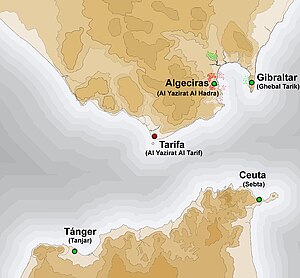
Year 1285 (MCCLXXXV) was a common year starting on Monday of the Julian calendar.
Tarifa is a Spanish municipality in the province of Cádiz, Andalusia. Located at the southernmost end of the Iberian Peninsula, it is primarily known as one of the world's most popular destinations for windsports. Tarifa lies on the Costa de la Luz and across the Strait of Gibraltar facing Morocco.
Algeciras is a municipality of Spain belonging to the province of Cádiz, Andalusia. Located in the southern end of the Iberian Peninsula, near the Strait of Gibraltar, it is the largest city on the Bay of Gibraltar.

The Battle of Río Salado also known as the Battle of Tarifa was a battle of the armies of King Afonso IV of Portugal and King Alfonso XI of Castile against those of Sultan Abu al-Hasan 'Ali of the Marinid dynasty and Yusuf I of Granada.

Abu Al-Hasan 'Ali ibn 'Othman, was a sultan of the Marinid dynasty who reigned in Morocco between 1331 and 1348. In 1333 he captured Gibraltar from the Castilians, although a later attempt to take Tarifa in 1339 ended in fiasco. In North Africa he extended his rule over Tlemcen and Hafsid Ifriqiya, which together covered the north of what is now Algeria and Tunisia. Under him the Marinid realms in the Maghreb briefly covered an area that rivalled that of the preceding Almohad Caliphate. However, he was forced to retreat due to a revolt of the Arab tribes, was shipwrecked, and lost many of his supporters. His son Abu Inan Faris seized power in Fez. Abu Al-Hasan died in exile in the High Atlas mountains.
Nasr, full name Abu al-Juyush Nasr ibn Muhammad, was the fourth Nasrid ruler of the Emirate of Granada from 14 March 1309 until his abdication on 8 February 1314. He was the son of Muhammad II al-Faqih and Shams al-Duha. He ascended the throne after his brother Muhammad III was dethroned in a palace revolution. At the time of his accession, Granada faced a three-front war against Castile, Aragon and the Marinid Sultanate, triggered by his predecessor's foreign policy. He made peace with the Marinids in September 1309, ceding to them the African port of Ceuta, which had already been captured, as well as Algeciras and Ronda in Europe. Granada lost Gibraltar to a Castilian siege in September, but successfully defended Algeciras until it was given to the Marinids, who continued its defense until the siege was abandoned in January 1310. James II of Aragon sued for peace after Granadan defenders defeated the Aragonese siege of Almería in December 1309, withdrawing his forces and leaving the Emirate's territories by January. In the ensuing treaty, Nasr agreed to pay tributes and indemnities to Ferdinand IV of Castile and yield some border towns in exchange for seven years of peace.

Abu al-Hajjaj Yusuf ibn Ismail, known by the regnal name al-Muayyad billah, was the seventh Nasrid ruler of the Emirate of Granada on the Iberian Peninsula. The third son of Ismail I, he was Sultan between 1333 and 1354, after his brother Muhammad IV was assassinated.
Abu Abdullah Muhammad ibn Ismail, known as Muhammad IV, was the ruler of the Emirate of Granada on the Iberian Peninsula from 1325 to 1333. He was the sixth sultan of the Nasrid dynasty, succeeding to the throne at ten years old when his father, Ismail I, was assassinated.
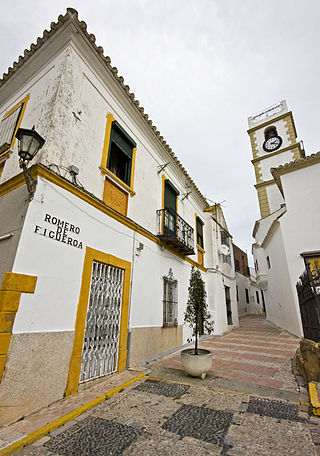
Juan Romero de Figueroa was a Spanish Roman Catholic priest, in charge of the Parish Church of St. Mary the Crowned during the last years of Gibraltar's Spanish period and first ones of the British period, until his death. He remained at his post even after the territory's capture by an Anglo-Dutch fleet in 1704 on behalf of the Archduke Charles, one of the claimants to the Spanish throne in the War of the Spanish Succession, when most of its population abandoned Gibraltar.
The Battle of Barcelona was a naval engagement fought in the coastal region of Barcelona, Catalonia, Spain, between the navies of the Crowns of Aragon and Castile, during the War of the Two Peters. A number of months beforehand, a large Castilian fleet had been assembled at Seville by order of the King of Castile, Peter I. Consisting of 128 warships including royal vessels, ships from the King of Castile's vassals, and several others that had been sent by the Castilian-allied monarchs of Portugal and Granada, this large fleet had been entrusted to the Genoese admiral, Egidio Boccanegra, who was seconded by two of his relatives, Ambrogio and Bartolome.
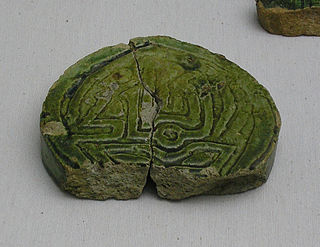
The Battle of Algeciras was a naval battle which occurred on July 25, 1278. The battle pitted the fleets of the Kingdom of Castile, commanded by the Admiral of Castile, Pedro Martínez de Fe, and the combined fleets of the Marinid dynasty and that of the Emirate of Granada, commanded by Abu Yaqub Yusuf an-Nasr. The battle was fought in the context of the Moorish naval expeditions to the Iberian Peninsula. The battle, which took place in the Strait of Gibraltar, resulted in a Muslim victory.

The siege of Algeciras was the first of many sieges of the city by Christian forces in the lengthy period of the Spanish Reconquista. The siege, ordered by King Alfonso X of Castile also known as "el Sabio", was a fruitless military campaign initiated by the Kingdom of Castile with the objective of removing the Benimerins from Algeciras. The siege on Algeciras, then known to the Muslims as Al-Jazira Al-Khadra, was strategically important because Algeciras had been at the time the main fortress and landing place for African reinforcement troops in the Iberian Peninsula. Castile, which had a powerful armada of ships anchored in the Bay of Gibraltar to blockade such reinforcement, had a few days previously to the siege, seen that fleet obliterated by the Muslim admiral, Abu Yusuf Yaqub at the Naval Battle of Algeciras.

The siege of Algeciras was a battle of the Spanish Reconquista that occurred between July 1309 and January 1310. The battle was fought between the forces of the Kingdom of Castile, commanded by King Ferdinand IV of Castile and his vassals, and the Emirate of Granada commanded by Sultan Abu'l-Juyush Nasr. The battle resulted in a humiliating defeat for the Kingdom of Castile whose army was obliged to lift the siege due to the atrocious conditions of life in the Castilian camp and the desertion of Infante John of Castile. The battle marked one of the many battles fought at Algeciras where the Christian forces would try to take the city unsuccessfully from the Muslims.
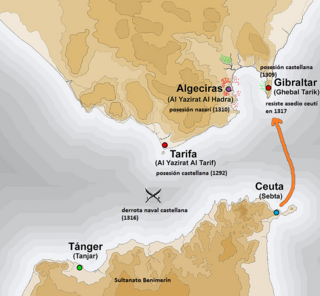
The second siege of Gibraltar was an abortive attempt in 1316 by the forces of the Azafid Ceuta and the Nasrid Emirate of Granada to recapture Gibraltar, which had fallen to the forces of Ferdinand IV of Castile in 1309.
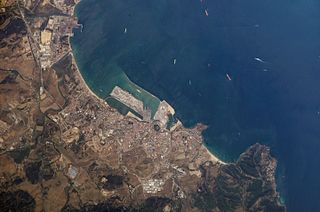
The siege of Algeciras (1342–1344) was undertaken during the Reconquest of Spain by the Castillian forces of Alfonso XI assisted by the fleets of the Kingdom of Aragon and the Republic of Genoa. The objective was to capture the Muslim city of Al-Jazeera Al-Khadra, called Algeciras by Christians. The city was the capital and the main port of the European territory of the Marinid Empire.
The siege of Almería was an unsuccessful attempt by Aragon to capture the city of Almería from the Emirate of Granada in 1309. Almería, a Mediterranean port in the southeast of the emirate, was the initial Aragonese target in a joint Aragonese-Castilian campaign aimed at conquering Granada. The Aragonese troops led by their King James II arrived on 11 August, blockading the city and employing siege engines. The city, led by governor Abu Maydan Shuayb and naval commander Abu al-Hasan al-Randahi, prepared for the siege by strengthening its defenses and stockpiling food. Throughout the siege, both sides exchanged shots from siege engines and engaged in fields battles and skirmishes with varying results. James ordered multiple unsuccessful assaults. A Granadan relief column under Uthman ibn Abi al-Ula arrived nearby in September and harassed the besiegers.
The Battle of the Strait was a military conflict contesting the ports in the Straits of Gibraltar taking place in the late thirteenth century and the first half of the fourteenth. The conflict involves principally the Spanish Muslim Emirate of Granada, the Spanish Christian Crown of Castile and the North African Muslim Marinid state. The ports' strategic value came from their position linking Spain and North Africa, thus connecting Muslims in Spain with the rest of the Islamic world. The campaign had mixed results. Castile gained Tarifa permanently, and managed to take Gibraltar and Algeciras but both would revert to Muslim rule. Castile also failed to gain any port in the African side of the strait.
The Battle of Ceuta (1309) was a military confrontation between the Crown of Aragon and the Nasrid kingdom of Granada in the city of Ceuta during the Castilian-Granadian War from 1309 to 1319. The Benimerin Sultanate wished to occupy the city but lacked a navy to carry out the enterprise. The Crown of Aragon, which had gone to war against the Granada, set out to conquer the city for the Benimerins.
María Teresa Sesé is a Spanish writer. Often regarded as one of the most prolific and popular writers in Spain, she is known for over 500 romance novels which were published between 1940 and 1975. She wrote most of her books in Spanish, but after studying Basque for two years, she wrote books in that language. Her works have been translated and republished in several languages.
